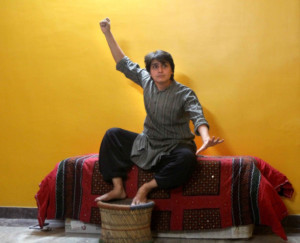Interview: FOUNDER OF KABULIWAALA Kamal Pruthi On Museum Theatre In India
 Theatre artist Kamal Pruthi has firmly established his place as one of the top most story tellers in India. An exceptional performing arts artist. Pruthi is known in theatre circuits as Kaabuliwaala. He is also a proud recipient of many theatrical honors such as being the recipient of Goethe Scholarship for young and emerging theatre practitioners of the world (2006). He has also received prestigious fellowships such as South Asian fellowship for excellence in the field of Arts management (2014) and Polska theatre fellowship from Poland (2015). He established Kaabuliwaala, a company that uses storytelling to revive and preserve ancient folk arts in India.
Theatre artist Kamal Pruthi has firmly established his place as one of the top most story tellers in India. An exceptional performing arts artist. Pruthi is known in theatre circuits as Kaabuliwaala. He is also a proud recipient of many theatrical honors such as being the recipient of Goethe Scholarship for young and emerging theatre practitioners of the world (2006). He has also received prestigious fellowships such as South Asian fellowship for excellence in the field of Arts management (2014) and Polska theatre fellowship from Poland (2015). He established Kaabuliwaala, a company that uses storytelling to revive and preserve ancient folk arts in India.
Pruthi is busy these days bringing to theatre goers a new experience in stagecraft -- the concept of Museum Theatre. he recently wrapped up the performance of Aadab Manto Saheb.
He talks to BWW about everything that one needs to know on Museum Theatre
BWW: What exactly is Museum Theater Style of Storytelling?
KP: Museum Theatre Style is an absolutely new, fresh and unconventional form of Storytelling and theatre. Here the audience, instead of being stationary or so to say comfortably seated at a reserved seat of an auditorium, rather moves within the expanse of a defined space, very much like in an actual museum and all through the length of the show audiences locate themselves as an integral part of the performance.
How does a Museum Theatre Guide ensure that the performance is more interactive and engaging?
The Museum theatre guide very much like the tour guide takes the audience around, not for sightseeing but here for a dramatic journey within the defined space, through the expanse of the premises where one after the other all the performances will be unfolded and the museum theatre guide lets you experience the art of storytelling in its raw and purest form.
There is no stage but just Performance Spots, now this sounds very intriguing. Tell us more?
There is absolutely no Stage or a so-called elevated platform in the Museum Theatre Form like in a stage theatre. "Performance Spots" or to say it in a layman's language Performance area is fixed within the entire premises in Museum Theatre Form keeping in mind the contexts of the stories, and their possible relationship with the designated space.
Interestingly No Curtains Go up too, how does that work?
In a "Stage" theatre form, by seeing the huge curtains, wings and broad wooden floorings, even a child can identify it as a stage or a performance area. In contrast, in "Museum Theatre form", the audience is never aware of the performance space and find themselves surprised. The performance space is perhaps in front of their naked eyes, it is yet unidentifiable until and unless the museum theatre guide comes, the drama begins, for a change, without any unfolding of curtains, no ringing of first, second and third bells and without switching off the house lights. A pleasantly surprised audience giggles, with or without expectations, thinking what to think of it, and what to make out of it. As Saadat Hasan Manto says "Main Aajkal soch raha hoon ki mujhe kya sochana chahiye" (these days, I'm thinking of what should I be thinking about?). Similarly, the food for thought for the audience is just being themselves and go by the flow, go by the subtle and slight directions of the Museum Theatre Guide.
How is the interaction between audience and the storytellers during the performance
Since there's hardly any distance or a wall between the audience and the storytellers, when there are no curtains, no green rooms, there is definitely a huge challenge and risk factor here for the artists to do a great amount of justice to their respective set of performances, to their characters, which they must hold and maintain long before and after the stories are told. On the contrary, a novel and casual atmosphere, excitement and a kinesthetic experience for the theatregoers who are very much used to the conventional and comfortable "Stage" form of theatre. A new set of experience awaits to hug them.
Comments

Videos

